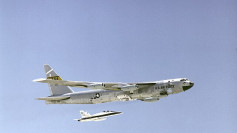Ukraine has launched a series of drone attacks on critical Russian air bases, marking a significant escalation in the ongoing conflict between the two nations. Over the past two days, Ukrainian forces have targeted key military installations, including the Marinovka air base in the Volgograd region, as part of a broader strategy to weaken Russia's air capabilities.
On Wednesday night, multiple explosions rocked the Marinovka military airfield, located in the southwestern Volgograd region. The attack, confirmed by regional governor Andrei Bocharov, resulted in a fire at a Russian defense ministry facility. While Bocharov reported that "most of the drones were destroyed" and there were "no casualties," videos circulating on social media depicted a massive fireball and plumes of smoke rising from the site.
This assault on Marinovka followed closely on the heels of a separate Ukrainian drone strike targeting the Olenya air base in Russia's Murmansk region, some 2,000 kilometers from the Ukrainian border. The Olenya base is known to host strategic bombers, including the Tu-95MS and Tu-22M3, which have been used to carry out long-range strikes on Ukrainian targets.
The coordinated attacks underscore Ukraine's increasing reliance on drone warfare to penetrate deep into Russian territory. These strikes, while not always publicly claimed by Ukrainian authorities, are believed to be the work of Ukraine's Security Service (SBU) and Main Intelligence Directorate (HUR), both of which have previously acknowledged responsibility for similar operations.
"Things aren't getting any better for the rapidly vanishing Russian air force as hungry Ukrainian drones claim another victim," tweeted the account "Jay in Kyiv," associated with the Serhiy Prytula Charity Foundation, which supports the Ukrainian military. The tweet, which included footage of the Marinovka attack, further fueled speculation about the effectiveness of Ukraine's drone strategy.
According to the Russian Ministry of Defense, 13 Ukrainian drones were intercepted over the Volgograd region during the Marinovka attack. Despite these defenses, reports from local sources indicated that up to 12 explosions were heard around the airfield, suggesting that some drones may have penetrated Russian airspace successfully.
The recent strikes are part of a broader Ukrainian campaign targeting Russian military airfields, ammunition depots, and other strategic assets. Kyiv has made it clear that such sites are considered legitimate targets in its effort to push back against Russia's invasion, which began in February 2022.
Ukraine's focus on drone warfare reflects its need to counterbalance Russia's superior air power. While Ukraine has received some advanced U.S.-made F-16 fighter jets, its air force remains outgunned by Russia's larger and more technologically advanced fleet. The use of drones, therefore, has become a critical component of Ukraine's military strategy, allowing it to strike deep behind enemy lines without risking its limited number of aircraft.
The attack on the Marinovka base is particularly significant because the facility is believed to house Su-34 fighter-bombers and Su-24 tactical bombers-aircraft that have been used in numerous assaults on Ukrainian positions. By targeting such assets, Ukraine aims to disrupt Russia's ability to conduct air operations, potentially shifting the balance of power in certain contested regions.
In addition to the military implications, these drone strikes also carry symbolic weight. They demonstrate Ukraine's capability to reach deep into Russian territory, challenging Moscow's narrative of invulnerability. This could have a psychological impact on both Russian forces and the civilian population, further complicating the Kremlin's efforts to maintain support for the ongoing conflict.
Looking ahead, it is likely that Ukraine will continue to leverage its growing drone capabilities to target critical Russian infrastructure. As the conflict drags on, these strikes may become more frequent and more sophisticated, increasing the pressure on Russian defense systems and potentially leading to a recalibration of Russia's military strategy.






